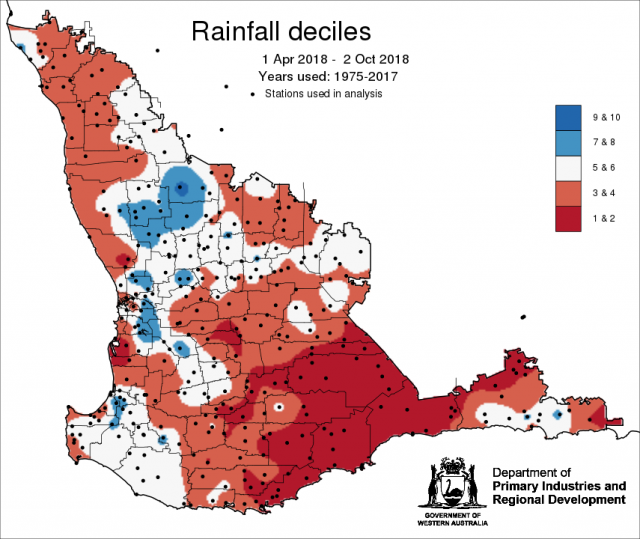Recent climate
September rainfall was below average for the grainbelt. The last three months’ rainfall (July to September) was generally average to below average. In the July Seasonal Climate Outlook, SSF indicated below median rainfall likely and the Bureau gave a neutral outlook. September maximum temperatures were average to above average and minimum temperatures were generally below average away from the south coast, with a wide spread frost event on 15 September. The rainfall decile map for 1 April to 2 October shows large parts of the grainbelt have received only decile 4 rainfall or lower.
In September the atmospheric pressure was higher than normal over southern Australia, contributing to the below average rainfall. The Indian Ocean sea surface temperatures continue to be cooler than average to Australia's north-west, which is likely acting to suppress rainfall over southern and central Australia.
The Southern Annular Mode (SAM), also known as the Antarctic Oscillation (AAO), describes the north–south movement of the westerly wind belt that circles Antarctica, dominating the middle to higher latitudes of the southern hemisphere. SAM is currently positive. In a positive SAM event, the belt of strong westerly winds contracts towards Antarctica, resulting in weaker than normal westerly winds and higher pressures over southern Australia, restricting the penetration of cold fronts inland. The National Oceanic and Atmospheric Administration (NOAA) suggests that SAM is likely to remain positive until mid-October.
The Indian Ocean Dipole (IOD) is currently neutral. Four of the six international climate models surveyed by the Bureau suggest that index values will remain above positive IOD thresholds into October, so this may be the start of a positive IOD event. It would take several more weeks of values above thresholds for a positive IOD event to be considered established. A positive IOD during spring typically reduces rainfall across much of the eastern two-thirds of Australia and can exacerbate any El Niño-driven rainfall deficiencies. However, IOD events usually decay by the start of summer.See the Bureau of Meteorology’s IOD and Pacific Ocean interaction for details.
The El Niño–Southern Oscillation is currently neutral, but El Niño may develop by late spring. El Niño typically results in below-average spring rainfall for northern and eastern Australia, and warmer days for the southern two-thirds of the country. By summer, the reduced rainfall influence from El Niño contracts to the tropical north.
The table below gives a summary of past month and three month south-west Western Australia climate conditions, and can be used as an indication of what is likely to occur in the near future if climate conditions follow the current pattern.
| Climate indicator | Past month | Past three months |
|---|---|---|
| SWWA Rainfall | Below average | Generally average |
| SWWA Mean Temperature | Average | Average to above |
| SWWA atmospheric pressure | Higher | Near normal |
| Indian Ocean Sea surface temperature | Cooler | Near normal |
| El Niño/Southern Oscillation (ENSO) | Neutral | Neutral |
| Indian Ocean Dipole (IOD) | Neutral | Neutral |
| Southern Annular Mode (SAM) | Positive | Near neutral |

